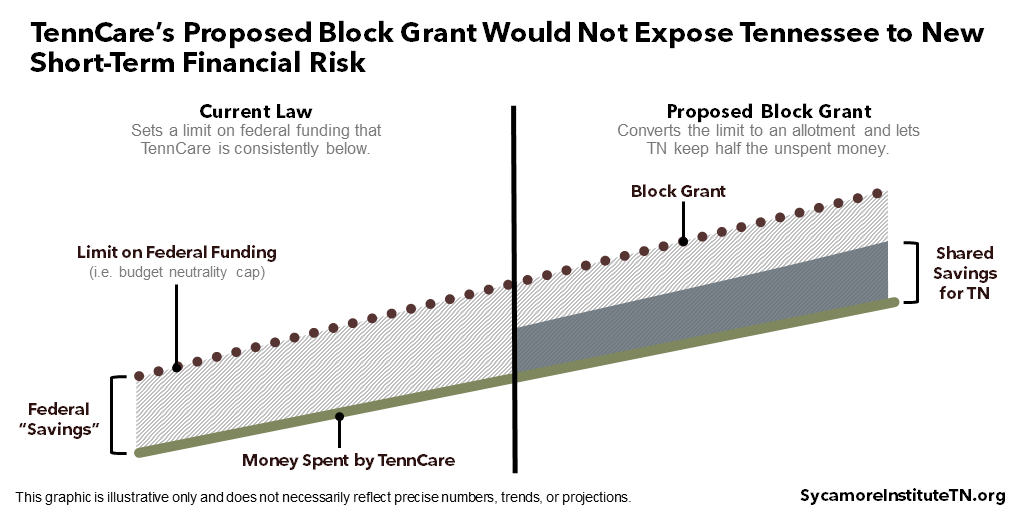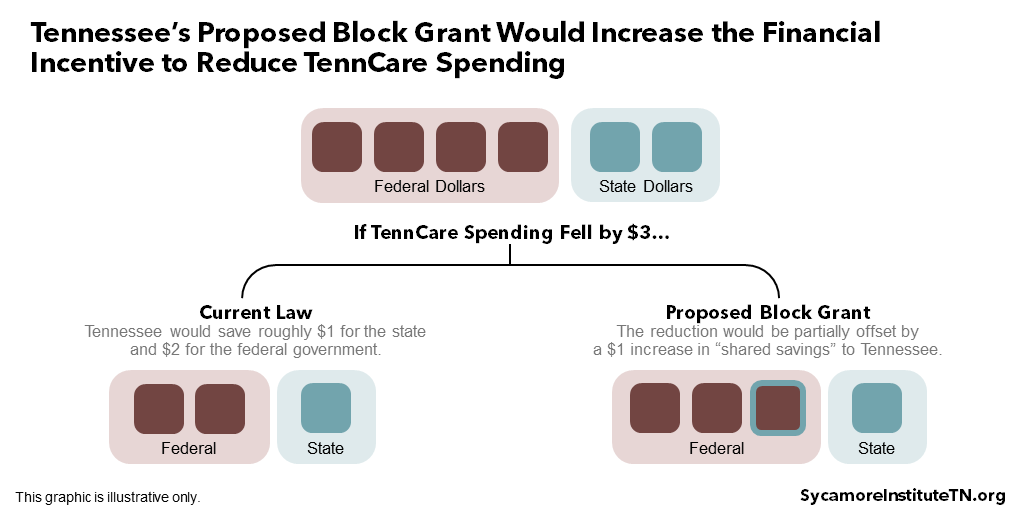TennCare officially submitted its opening bid in negotiations with federal regulators over a Medicaid block grant this week. (1) (2) The current proposal retains the same basic components as the September 2019 draft but adds a limited set of new specifics and assurances.
This brief explains what the current proposal for a “modified” block grant could mean for TennCare, the state’s Medicaid program. After a 30-day federal comment period, state and federal officials will negotiate the framework and details of this proposal for an undetermined period of time.
Key Takeaways
- The proposed funding structure is not substantively different from the September draft and would:
- Not expose Tennessee to any more short-term financial risk than the state already faces under current law.
- Likely bring more federal funding to Tennessee than is available under current law.
- Increase the financial incentive to reduce spending on TennCare.
- The latest proposal clarifies that new flexibilities cannot be used to scale back benefits and identifies near-term priorities for using the flexibilities that would largely be positive for enrollees.
- Given the degree of flexibility and the complex set of new incentives and opportunities for current and future state policymakers, the net effect on TennCare enrollees and providers could be positive, negative, or mixed.
The Funding Structure
The proposed funding structure is not substantively different from the September draft. It includes:
- A block grant to replace current federal funding for a portion of TennCare costs.
- The opportunity to keep half (without a state match requirement) of any savings from spending less than the full block grant.
Figure 1

Some of the debate around Tennessee’s plan has, at times, mistakenly equated it with the Medicaid block grant proposals Congress debated in 2017. Some features are similar. However, the anticipated impact on federal funding would be very different due to the details of the latest proposal and TennCare’s spending under the current structure. As our analysis of the September draft lays out in more detail:
- The proposed block grant would not expose Tennessee to any more short-term financial risk than the state already faces under current law. TennCare currently operates under a federal waiver, which sets a limit on federal funding for the program (officially called the “budget neutrality cap”). State policymakers are proposing to convert that upper limit into a new federal block grant (Figure 1). This is markedly different than 2017 Congressional proposals, which specifically aimed to reduce federal Medicaid funding below what’s expected under current law.
- Tennessee would likely get more federal funding under the block grant than is available under current law. TennCare’s current federal funding limit is based on the Medicaid costs and trends in other states. It represents, in theory, what the federal government would spend on TennCare if the existing waiver were not in effect. By consistently spending less than that limit, Tennessee creates hypothetical “savings” for the federal government compared to national Medicaid trends. Today, the federal government keeps all of those savings. The block grant proposes to let Tennessee keep half of the savings to spend on improving the health of TennCare enrollees (Figure 1).
- The block grant would increase the financial incentive to reduce spending on TennCare. Under current law, for example, reducing total TennCare spending by $3 saves roughly $1 for the state and $2 for the federal government. Under this proposal, the drop in federal funding would be partially offset by a $1 increase in “shared savings” that Tennessee could use for purposes that improve the health of TennCare enrollees (Figure 2).
Figure 2

The Flexibilities
The revised proposal adds assurances to a broad set of benefit design and administrative flexibilities that Tennessee could tap without prior federal approval or oversight. It does not include any changes that would affect eligibility. This section summarizes what changed and what remained the same since the September draft.
The proposal now clarifies that new flexibilities cannot be used to reduce or scale back benefits. The September draft would have let Tennessee make any changes, reductions, and eliminations to optional or mandatory benefits already allowed under federal law without getting federal approval. The revised version eliminates the approval process only for improvements or additions. If TennCare wanted to reduce or eliminate benefits, it would have to go through the same federal approval processes as today.
TennCare identifies several near-term priorities for using the flexibilities and shared savings that would largely be positive for enrollees. Among the top priorities mentioned are extending post-partum coverage of pregnant women on TennCare from two to twelve months and providing preventive dental coverage for pregnant and post-partum women. Both of these priorities are also proposed as part of TennCare’s FY 2021 budget request to the governor. (3)
State officials continue to seek new flexibilities not currently offered by federal law or regulation while offering some new assurances. For example, the proposal continues to ask for permission to institute a drug formulary. However, new language now outlines considerations for setting the formulary (e.g. medical necessity), ensures there would be an exceptions process, and carves out children under 21.
Other requests from the September draft were largely unchanged — for example, the ability to use Medicaid dollars to fund broader public health initiatives and to support technology adoption in rural areas.
TennCare also continues to request exemptions from federal oversight requirements for managed care plans. The revised plan echoes stakeholders’ concerns about the need for oversight of managed care plans but maintains that the federal regulations add “unnecessary administrative burdens” to carrying out that oversight.
The Bottom Line
The proposed funding structure and flexibilities in this “modified” block grant create a complex set of new incentives and opportunities for state policymakers. For example, a block grant could bring more federal dollars to Tennessee even without other changes to the program. The new flexibilities would reduce the administrative burden of putting those dollars to use in new areas and also broaden what those dollars could be used for.
Meanwhile, the shared savings model would increase the incentives for making changes to TennCare that reduce spending. The flexibilities would create new opportunities to not only generate overall savings but also spend the resulting shared federal savings in new ways. For example, new flexibilities would let Tennessee use Medicaid dollars on efforts that affect health broadly instead of on health care alone.
It remains impossible to predict the net effect on enrollees and providers from the use of a drug formulary and other flexibilities — which may be positive, negative, or mixed. Even with the changes discussed above, the proposal remains intentionally broad to give state officials discretion over exactly how to apply the requested flexibilities. At the same time, current and future state policymakers will face a complicated set of incentives in deciding if and how to use this new authority. These factors suggest a wide range of outcomes are possible.
What’s Next?
A few key facts about the process and what’s next:
- The federal Centers for Medicare and Medicaid Services (CMS) will soon publish Tennessee’s proposal online and begin a 30-day public comment period. (4)
- Once the federal comment period is closed, Tennessee and the federal government will engage in discussion and negotiation. (4)
- There are no defined time period or public transparency requirements for the state and federal negotiation process. (4) Waiver negotiations sometimes take years to complete.
- Tennessee currently has five other pending waiver amendments with CMS. The oldest was submitted on May 24, 2018.(5) There is no requirement that CMS consider amendments in the order in which they were received.
- Any final agreement between CMS and TennCare would have to be approved by state legislators before taking effect. (6)
References
Click to Open/Close
- Division of TennCare. Amendment 42: Modified Block Grant and Accountability. [Online] November 20, 2019. https://www.tn.gov/content/dam/tn/tenncare/documents2/Amendment42FinalVersion.pdf.
- —. Amendment 42: Modified Block Grant and Accountability (Redline Version). [Online] November 20, 2019. https://www.tn.gov/content/dam/tn/tenncare/documents2/Amendment42RedlineVersion.pdf.
- —. Proposed FY 2021 Budget. [Online] November 6, 2019. https://www.tn.gov/content/dam/tn/tenncare/documents/TennCareProposedBudgetFY21.pdf.
- Center for Medicare and Medicaid Services. 42 CFR Part 431. [Online] February 27, 2012. https://www.govinfo.gov/content/pkg/FR-2012-02-27/html/2012-4354.htm.
- Centers for Medicare and Medicaid Services. TennCare II: Pending Applications and Related Documents. [Online] [Accessed on November 21, 2019.] Available at https://www.medicaid.gov/medicaid/section-1115-demo/demonstration-and-waiver-list/?entry=8387.
- State of Tennessee. Public Chapter No. 481 (2019). [Online] May 24, 2019. https://publications.tnsosfiles.com/acts/111/pub/pc0481.pdf.

